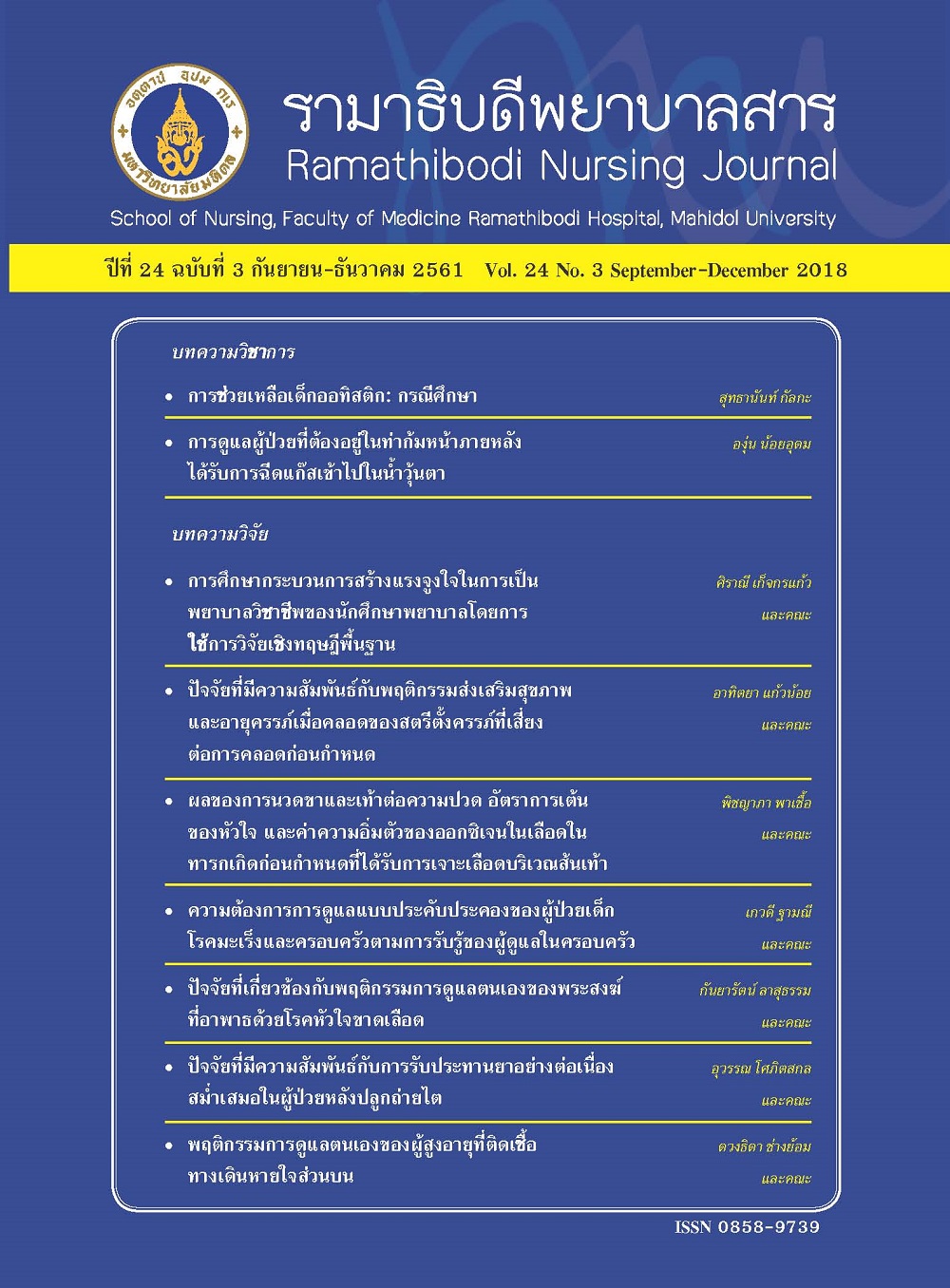Care of Patients with Face-Down Position after Inserting Gas in the Vitreous Cavity
Main Article Content
Abstract
Face down position is the most important activity for patients who were diagnosed retinal detachment or macular hole and treated by inserting gas in the vitreous cavity. Gas would float up for pressing retinal detachment to original position or closing a hole when patient stay on face down position. If the patient cannot keep face down position, the complication will occur such as cataract, high ocular pressure, and re-detachment. There are variety barriers that make patients cannot keep face down position for long time, 16 hour per day; even they know its importance. This article will present the knowledge of retinal detachment and macular hole, and treatment. The patients’ experience will be explored about the preparing before and after operation, and also the effect of face down position on physical, mental, and emotional. The nurses’ role will be explained for helping patient to keep face down position effectively.
Article Details
บทความ ข้อมูล เนื้อหา รูปภาพ ฯลฯ ที่ได้รับการตีพิมพ์ในรามาธิบดีพยาบาลสาร ถือเป็นลิขสิทธิ์ของวารสาร หากบุคคลหรือหน่วยงานใดต้องการนำทั้งหมดหรือส่วนหนึ่งส่วนใดไปเผยแพร่หรือเพื่อกระทำการใด ใด จะต้องได้รับอนุญาตเป็นลายลักษณ์อักษรจากรามาธิบดีพยาบาลสารก่อนเท่านั้น
References
2. Ghazi NG, Green WR. Pathology and pathogenesis of retinal detachment. Eye. 2002;16:411-21.
3. Steel D. Retinal detachment. BMJ Clin Evid. 2014;2014: 1-32
4. Chandra A, Charteris DG, Yorston D. Posturing after macular hole surgery: a review. Ophthalmologica. 2011;226:3-9.
5. Rahat F, Nowroozzadeh MH, Rahimi M, Farvardin M, Namati AJ, Sarvestani AS, et al. Pneumatic retinopexy for primary repair of rhegmatogenous retinal detachments. Retina. 2015;35: 1247–55.
6. Mandelcorn ED, Mandelcorn MS, Manusow JS. Update on pneumatic retinopexy. Curr Opin Ophthalmol. 2015;26:194-9.
7. Gupta D. Face-down posturing after macular hole surgery: a review. Retina. 2009;24:430-43.
8. Krohn J. Duration of face-down positioning after macular hole surgery: a comparison between 1 week and 3 days. Acta Ophthalmol Scand. 2005;83:289-92.
9. Brinton DA, Chiang A. Pneumatic retinopexy. In: Ryan SJ, editor. Retina. 5th ed. China: Saunders; 2013. p. 1721-34.
10. Chergui K, Choukroun G, Meyer P, Caen D. Prone positioning for a morbidly obese patient with acute respiratory distress syndrome: an opportunity to explore intrinsic positive end-expiratory pressure–lower inflexion point interdependence. Anesthesiology. 2007;106:1237-9.
11. Cunningham C, Scheuer L, Black S. Developmental juvenile osteology. 2nd ed. San Diego: Academic Press; 2016. p. 177-223.
12. Lebreton O, Weber M, Delbosc B. Reasons for readmission to hospital after vitreoretinal surgery: 5-year retrospective follow-up. J Fr Ophtalmol. 2009;32:32-40.
13. Rayat J, Almeida DRP, Belliveau M, Wong J, Gale J. Visual function and vision-related quality of life after macular hole surgery with short-duration, 3-day face-down positioning. Can J Ophthalmol. 2011;46:399-402.
14. Tatham A, Banerjee S. Face-down posturing after macular hole surgery: a meta-analysis. Br J Ophthalmol. 2010;94:626-31.
15. Roy SC. Roy adaptation model. In: Masters K, editor. Nursing theories: a framework for professional practice. 2nd ed. USA: Jones & Bartlett learning; 2015. p. 113-26.


